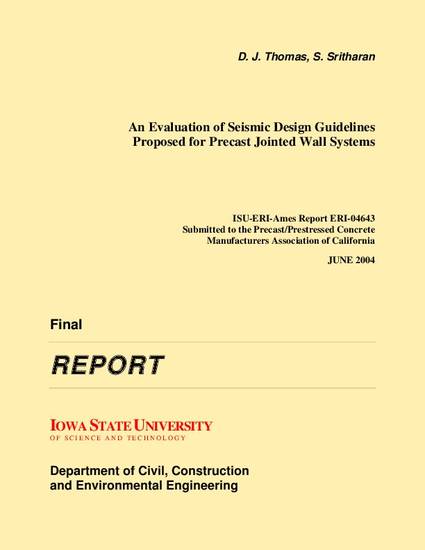
Article
An Evaluation of Seismic Design Guidelines Proposed for Precast Jointed Wall Systems
Reports and White Papers
Document Type
Report
Publication Date
6-1-2004
Report Number
ISU-ERI-Ames Report ERI-04643
Granting or Sponsoring Agency
Precast/Prestressed Concrete Manufacturers of California
Disciplines
Abstract
Following the satisfactory response of the unbonded post-tensioned precast concrete jointed wall system tested for seismic performance as part of the PREcast Seismic Structural Systems (PRESSS) test building, a set of design guidelines was published. The primary objective of the research presented in this report is to evaluate the adequacy of the design guidelines and make appropriate recommendations so that the guidelines can be adopted for design of jointed precast walls in seismic regions. The test data to date on such systems are those collected during the wall direction testing of the PRESSS test building. Hence, this data set has been employed in the validation process.
Furthermore, in order to validate the design guidelines over a range of lateral displacements, an analytical procedure was first developed by reversing the suggested guidelines. Additionally, because of the shortcomings associated with the use of the equivalent stress block concept in design, an alternative analysis method was also considered, which was based on the monolithic beam analogy (MBA) originally developed for jointed frame systems. The analytical results from monotonic loading were compared to experimental response of the jointed wall established from the PRESSS test data.
It was found that the analysis method based on the PRESSS guidelines underestimated the lateral load resistance of the jointed wall in the PRESSS test building by up to 22% at large lateral displacements and overestimated by greater percentages at small displacements. When the force transferred through the shear connectors was based on the measured force-displacement response, the PRESSS guidelines and MBA underestimated the moment response of the jointed wall by 12% and 5%, respectively, at the maximum measured lateral displacement. However, utilizing the PRESSS guidelines with the measured force in the shear connectors, it was found that the neutral axis depth was overestimated by over 100% and the post-tensioning elongation was underestimated by 26%. It was also revealed that the framing action contributed to the moment resistance in the wall direction of the PRESSS building by as much as 25%. Several recommendations are provided for improving the PRESSS design guidelines, which will simplify the design calculations while providing efficient design details for the precast jointed wall systems. With improvements, the PRESSS guidelines are shown to predict the observed performance of the jointed wall in the PRESSS test building satisfactorily.
Language
en
File Format
application/pdf
Citation Information
Derek J. Thomas and Sri Sritharan. "An Evaluation of Seismic Design Guidelines Proposed for Precast Jointed Wall Systems" (2004) Available at: http://works.bepress.com/sri_sritharan/6/
